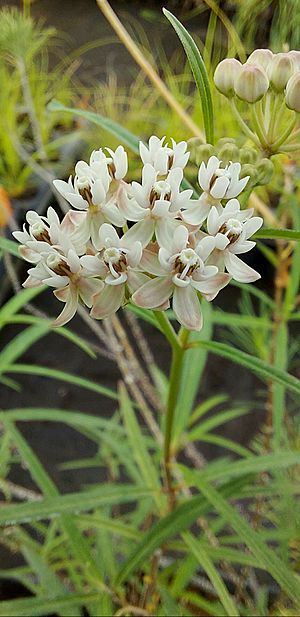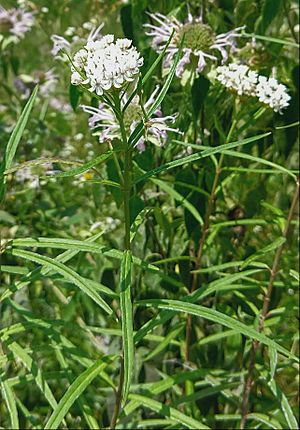Arizona milkweed facts for kids
Quick facts for kids Arizona milkweed |
|
|---|---|
 |
|
| Scientific classification | |
| Genus: |
Asclepias
|
| Species: |
angustifolia
|
The Asclepias angustifolia, often called the Arizona milkweed or talayote, is a special plant. It is found only in Arizona, USA. This plant is a type of milkweed, which is very important for many insects.
About the Arizona Milkweed
The Arizona milkweed is a plant that comes back every year. It has a deep root and can grow to be about 60 to 90 centimeters (2 to 3 feet) tall. Many stems can grow from one plant.
Its leaves are long and thin, like blades. They are about 4 to 12 centimeters (1.5 to 4.5 inches) long. The flowers grow in clusters at the top of the stems. Each flower is small, about 3 millimeters (0.1 inches) wide. Their color can be white or light pink. After the flowers, the plant makes long, thin pods. These pods are about 3.5 to 9 centimeters (1.5 to 3.5 inches) long. Inside the pods are many seeds. Each seed is about 4 millimeters long and has a silky white fluff attached to it. This fluff helps the seeds fly away in the wind.
Where Does It Live?
You can find the Arizona milkweed in higher places, usually between 1050 and 2100 meters (3,445 to 6,890 feet) high. It grows in only three counties in Arizona: Pima, Santa Cruz, and Cochise.
This plant likes dry, rocky soil. It often grows near rivers, in open fields, or in canyons. The Arizona milkweed is quite rare in Arizona. It is mostly found near the border areas.
The Arizona milkweed is a very important plant for the Monarch butterfly. Monarch caterpillars eat only milkweed plants. So, this plant is a "host plant" for them. Small Carpenter Bees (called Ceratina species) have also been seen pollinating its flowers. This means they help the plant make seeds.
Growing Arizona Milkweed
You can buy Arizona milkweed as seeds or as young plants. The seeds grow easily. You can have a flowering plant in just three months! These plants can grow well even in small pots.
The Arizona milkweed is tough. It can handle both too much water and not enough water. It also grows well in different types of soil, from rich garden soil to sandy soil. It can even survive cold temperatures, down to about -12 degrees Celsius (10 degrees Fahrenheit).
Images for kids




